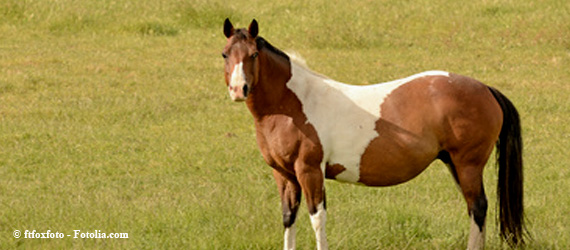 When foals are born prematurely, many people tend to think it’s just one of those things. Causes such as placentitis (inflammation of the uterus) are fairly well-known, although the causes behind many premature births remain a mystery.
When foals are born prematurely, many people tend to think it’s just one of those things. Causes such as placentitis (inflammation of the uterus) are fairly well-known, although the causes behind many premature births remain a mystery.
What’s less recognised is that the mare’s general health is often a factor in prematurity, and that how we feed the mare can have a strong influence on this.
It’s easier to think that an underlying infection just happened anyway, or that some other external factor caused the premature birth.
Something toxic that was accidentally eaten by the mare, a traumatic event or an uncontrollable infection are far easier reasons to latch on to, rather than acknowledging that our own approach to feeding the mare may have contributed.
How Can Horses Have a First or Third World Pregnancy?
In horses as in humans, the diet of expectant mothers can have a huge effect on the outcome of the birth and the infant’s development. In humans, there are differences between the problems that occur in developed and under-developed countries.
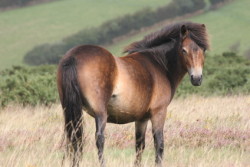
In poorer nations, bad nutrition due to lack of food is an issue, whereas in wealthier nations, the problems are often linked to obesity and eating too much of the wrong type of food.
It’s the same with horses. However, a mare experiencing a First World pregnancy can be in the same country, region or town as a mare experiencing a Third World pregnancy, because it all comes down to how the owner manages that horse. They could even be in neighbouring paddocks.
That’s not to say that regional issues such as drought or over-abundant rich grass don’t make a difference – of course they do. And it’s not being over dramatic to compare drought affected areas with famine zones.
Yet it’s how we respond to those challenges that marks out how they affect the mare. But can a mare’s feed affect the chances of a foal being born prematurely? Sometimes, but not always – but that’s no reason to overlook it. If we can tilt the odds towards a healthy outcome for a pregnant horse, then it’s up to us to do so.
And the great thing is that if we feed the mare properly and a foal is born after a full-term gestation, good nutrition will improve its chances of being born in great health and with a good start in life..
© All text copyright of the author, Jane Clothier, https://thehorsesback.com. No reproduction of partial or entire text without permission. Sharing the link back to this page is fine. Thank you!
Nutrition, Placentitis and Premature Foals
Through good nutrition, we can influence the chances of our mares experiencing one of the biggest causes of equine prematurity – placentitis.
Placentitis accounts for around 1/3 of late abortions, premature births, and births of full-term but weakened (dysmature) foals. It can also lead to the foal’s death in the first day or two of life, as the foal can be infected in the uterus with the same bacteria that caused the problem.
The most common form is ascending placentitis, where the mare’s uterus is infected by bacteria (commonly a streptococcus species) via the reproductive tract. I won’t try to describe the process here – there are lots of descriptions online that do the job perfectly well and far better than I can.
The premature birth occurs because the tissues in the reproductive tract become inflamed and the mucus layers that protect the uterus become compromised. Once the placenta itself is affected and damaged, the foetus can’t be supported. Without veterinary intervention, a premature birth can easily follow.
Why an Underweight Mare May Have a Premature Foal
Placentitis is a greater risk for underweight and undernourished mares.
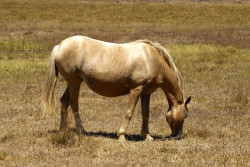
First, they are likely to have a compromised immune system, as they haven’t received the correct nutrition for function of their organs. Second, in these mares, the anus can also become sunken and swollen, causing the vulva’s opening to widen, making it easier for faecal bacteria to enter. It’s then easier for the bacterial infection to break down the cervical mucus barriers and invade the uterus.
If the mare has a depleted immune system, she is more vulnerable to infections anyway. This is just one of many double whammys that accompany malnutrition.
Even if placentitis isn’t involved, plain old lack of food can still lead to prematurity. Research shows that if a pregnant mare is severely undernourished, the placenta compensates by becoming thicker. So while the foal may be smaller due to lack of nutrition, it also has less space within which to survive.
This again can make a premature birth more likely, with a greater chance of an underdeveloped foal that needs veterinary attention.
Another risk of an enlarged placenta is dystocia, or incorrect foetal positioning due to a restricted growth space in the uterus. This often leads to premature birth as well.
On top of that, when the mare is undernourished, her colostrum and milk production may be poor – even more so if the birth is also premature – reducing the foal’s chances of a healthy start even further. It’s another double or even triple whammy.
Why an Overweight Mare May Have a Premature Foal
Remember that a round and shiny mare is not necessarily a healthy round and shiny mare.
Aside: did you know that overweight pregnant women on a high sugar, high carbohydrate diet have a greater chance of having a premature birth than women with a healthy diet? (Cnattingius S, Villamor E, Johansson S, et al. Maternal Obesity and Risk of Preterm Delivery. JAMA. 2013;309(22):2362-2370. doi:10.1001/jama.2013.6295.)
If a mare is overweight with abundant grazing and low exercise levels, her obesity may be linked to sub-clinical laminitis – ie, the signs are not yet noticeable, as the hooves aren’t visibly showing the effects, although her metabolism is affected.
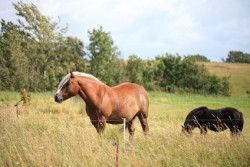
Many so-called good-doers or easy-keepers are affected by Equine Metabolic Syndrome, previously known as insulin resistance, which also results in obesity and laminitic outbreaks. A mare that is already insulin resistant can abort or have a premature foal.
Here’s how. High insulin can cause inflammation in the reproductive tract, just as in the hooves. The inflammation leads to changes in the mucus production, and this can allow chronic uterine infections to happen. And here we are, back to risk of ascending placentitis.
On top of this, insulin levels normally rise during pregnancy, meaning that a mare with pre-existing high insulin levels may have serious issues that cause her to founder before foaling. (If she suffers a retained placenta, then the chances of toxic laminitis are even higher, with foundering happening quicker if the hooves are already compromised.)
Incidentally, over-feeding can lead to difficult births, with obese mares lacking the muscle tone for effective contractions. Links have also been established to over-long pregnancies that produce dysmature (under-developed although full-term) foals. Dysmature foals can have similar musculoskeletal issues to premature foals.
Remember that horses can be overweight without having Equine Metabolic Syndrome, simply because they’re being overfed and are getting too many calories. Good care does not equate to giving over-large feeds. There are kinder ways to show your horse that you love her.
Feeding to Reduce the Risk of a Premature Foal
Clearly, you can’t tell whether a mare has a healthy diet simply by looking at her, even though a condition score will indicate whether she’s too thin or too weight.
So play safe. Get her nutritional needs even half right and you’ll dramatically improve your mare’s chances of a problem-free pregnancy, and the newborn foal’s chances of healthy development in its first months of life.
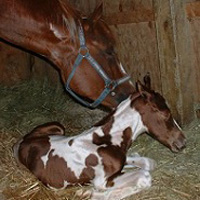
There are as many approaches to nutrition out there as there are approaches to other areas of horse care, but most agree on the general principles of feeding a pregnant mare. Look at the commercial feed companies’ advice pages and you’ll see the same points coming up again and again.
To repeat, there are many causes of prematurity. However, it makes sense to influence those that we can influence, even when it’s something as simple and easy as feeding the right stuff. This means avoiding those First and Third World pregnancy problems by feeding the mare for good nutritional health – for herself and the unborn foal.
I’ve listed the key points in this single page PDF: Feeding the Pregnant Mare
1. Energy intake
Most of the embryo’s growth occurs during the last stages, the so-called third trimester, of pregnancy. For this reason a mare in the last 3 to 4 months of pregnancy needs a higher energy intake, but without the calories. What she needs is more protein. What she doesn’t need is more carbohydrates.
Protein is used in the unborn foal’s development. 22 amino acids make up protein, but lysine is critical for development. If it is too low or missing, it will prevent the protein being utilised effectively in the foal’s growth in the uterus.
So while you’re upping the fiber available and mixing up extra feeds during these last months, it’s important not to rely on high levels of grains and mixed feeds containing molasses. Instead, if your grass is depleted or poor quality, you should focus on good quality hay, fed little and often (there won’t be space for large feeds in her gut due to the growing foal).
2. Roughage
Constant access to low-carb roughage will help to maintain the mare’s digestive functions. Why should you limit carbohydrate intake? Undigested carbohydrates add to the risks for horses with Equine Metabolic Syndrome, as mentioned earlier. In any horse, an overload can upset the gut’s microbial population, increasing colic risk.
Both conditions can cause pregnancy issues and premature birth. Colic can create unacceptable uterine conditions, leading to premature birth, while elevated insulin due to high carbohydrate levels can open the way for secondary uterine infections (as mentioned earlier).
3. Minerals – General Points
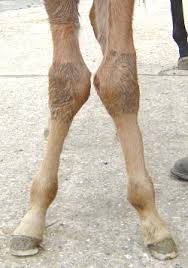
Ensuring an appropriate mineral intake is really important. It’s vital for the mare’s immune system, meaning she is at reduced risk of infections, including the bacterial infections that lead to ascending placentitis.
It’s reasonably well-known that macro minerals (including calcium and phosphorus) and trace minerals (including copper and zinc) are essential for the unborn foal’s health bone and joint growth. If you want to minimise the risk of angular limb deformities of any growing foal, be sure to get these right when you’re feeding the mare.
There’s something even more important. The mare’s milk is low on mineral content, so the unborn foal stores essential trace minerals (zinc, copper, selenium and manganese) in its liver for use during the first 3 months of its life. It’s not going to get them anywhere else once it’s born.
4. The Most Important Minerals
So, when it comes to minerals, if you deprive the mare, you’re also depriving the newborn foal.
Calcium is vital for the structure, mineralization and strengthening of the developing foal’s bones. It’s also crucial for milk production. Calcium deficiency has also been associated with dystocia (incorrect positioning of the foetus, leading to birth complications).
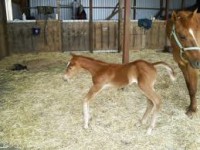
In combination with phosphorous, calcium also plays a role in brain and nerve function. Phosphorous must be present in the right proportion for calcium to be absorbed – most commonly quoted is 2 parts calcium to 1 part phosphorous (ie, 2:1 ratio).
Foals not receiving enough copper have more early osteopathic problems, including physitis and angular limb deformities (particularly flexural deformity – think club feet). You don’t want any of these problems in your foal, which needn’t be premature to have them.
Horses can’t get nutritional iron deficiency, despite the fact that foals do need more than adult horses. It’s not widely known, but excess iron can actually lead to a relative deficiency in copper and zinc, leading to joint issues.
Selenium is hugely important. With too little, there’s a greatly heightened risk of a retained placenta, which, if not treated urgently, leads to toxicity and a critical laminitis episode in the mare. This could kill her.
It’s also true is that selenium is vital for functional immune and antioxidant systems, and therefore lower risk of infection. Low selenium can also lead to poor quality colostrum – this is a major issue for any foal, but massively so for a weakened premature foal. It’s another triple or even quadruple whammy.
Be careful. Many commercial supplements are high in iron, but low in selenium. You need to get the dosage right, as too much selenium can be fatal too. You can read more here.
Iodine requirements are also complicated. Either too little or too low can lead to a foal with incomplete development of the joints. Adding indiscriminate amounts of kelp to the mare’s feed isn’t a good idea.
Think About Prematurity Before It Happens
The best time to start thinking about pregnancy issues in your mare is before you need to.
Rather than keep worrying about horror stories in social media, take a short while to get informed on the basics of feeding the pregnant mare.
It needn’t be complicated or expensive – if you get the above factors right, yet it could make a huge difference.
Nobody wants the trauma of a premature or under-developed foal, so it’s wise to do what you can to minimise the causes of that happening.
With good nutrition, you can aim for the best of a First World pregnancy by reducing the chances of problems, even though nobody can eliminate them all.
I intentionally haven’t gone into quantities or amounts in this article, with the exception of the calcium-phosphorous ratio. I recommend getting a hay or pasture test done before organising your mare’s feed, so that you know exactly what’s already going into her system already. Many major feed companies as well as government agriculture departments offer this service. In Australia, I recommend this service from Carol Layton of Balanced Equine: Why Test Your Pasture or Hay?
© All text copyright of the author, Jane Clothier, www.thehorsesback.com. No reproduction of partial or entire text without permission. Sharing the link back to this page is fine. Please contact jane@thehorsesback.com for more information. Thank you!
Excellent way of describing, and good post to take information regarding
my presentation focus, which i am going to present in school.